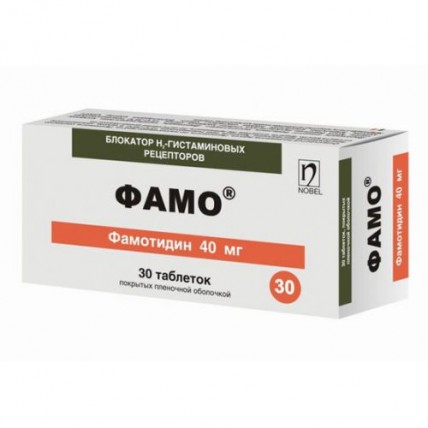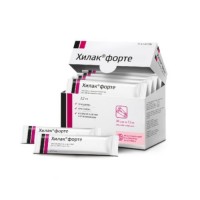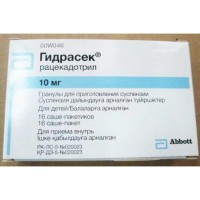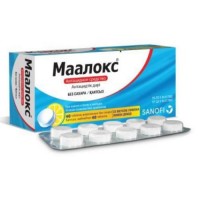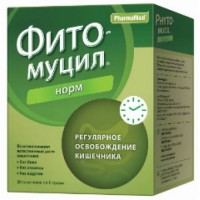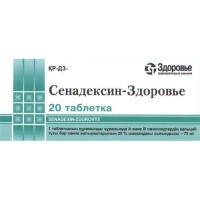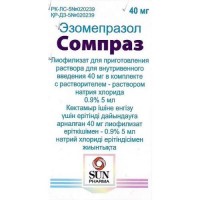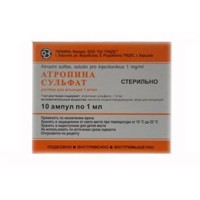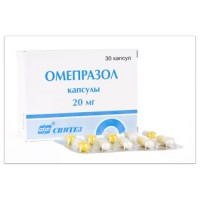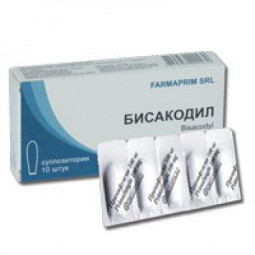FAMO 30s 40 mg coated tablets
- $8.10
The instruction for use
of medicine for experts
ФАМО®
Trade name
ФАМО®
the International unlicensed
name Famotidine Dosage Form
of the Tablet, film coated, 40 mg
Structure
One tablet contains
active agent – famotidine of 40 mg,
excipients: corn starch, lactose, cellulose microcrystalline PH 102, magnesium stearate, aerosil 200,
structure of a cover: opadray brown
the Description
Round, biconvex, film coated tablets of brick color, with risky on one party
Pharmacotherapeutic group
Drugs for treatment of a peptic ulcer. Blockers of N2-of histamine receptors.
The code of automatic telephone exchange A02BA03
the Pharmacological
Pharmacokinetics Later properties of intake ФАМО® is soaked up from digestive tract quickly, but not completely. The maximum concentration in blood plasma (Cmax) is reached in 2 h. The bioavailability is 40-45% and slightly changes in the presence of food. Linking with blood proteins makes 15-20%. Elimination half-life (T1/2) makes about 3 h of blood plasma and increases at patients with renal failures. A small part of active agent is metabolized in a liver with formation of famotidine of S-oxide. Half-life period 2.5-3.5 hours. Famotidine is removed by kidneys and a liver. 25 - 30% of a dose – are removed with urine in an invariable look.
Pharmacodynamics
ФАМО® is an antagonist of H2-of histamine receptors and suppresses discharge of gastric juice. Famotidine inhibits basal and night secretion of hydrochloric acid. Famotidine does not influence or influences gastrin level in blood serum at its use on an empty stomach or a little after a meal. Famotidine does not affect gastric evacuation and exocrine function of a pancreas.
Indications
- functional dyspepsia (heartburn, pains in epigastriums)
- a gastroesophageal reflux disease (GERD)
- a peptic ulcer of a stomach and duodenum
- Zollinger's syndrome – Ellisona.
The route of administration and doses
Adults and children are more senior than 12 years
At exacerbation of a peptic ulcer of a duodenum the recommended dose for oral administration - 40 mg once a day before going to bed. Therapy duration - 4-8 weeks. The recommended dose for oral administration in a recurrent duodenal ulcer - 20 mg once a day before going to bed.
At an easy course of a peptic ulcer of a stomach the recommended dose for oral administration - 40 mg once a day before going to bed. Duration of treatment is 6-8 weeks.
At Zollingera-Ellison's syndrome the recommended dose for oral administration - to 20 mg is each 6 hours. The dosage can be increased to 160 mg depending on a condition of the patient. Duration of treatment depends on a condition of the patient and disease severity.
In a gastroesophageal reflux disease (GERD) the recommended dose for oral administration of 20 mg or 40 mg twice a day, lasting treatment up to 12 weeks.
At treatment of a peptic ulcer and GERD associated with Helicobacter pylori FAMO® it has to be used as a part of complex eradikatsionny therapy.
At patients with a renal failure (the clearance of creatinine less 30 ml/min.) the recommended dose can be reduced to 20 mg a day or to increase intervals between receptions till 36-48 o'clock, without reducing a dose.
If necessary it is possible to apply together with antacids.
Side effects
- a headache, dizziness
- an anaphylaxis, a face edema or an eye, urticaria, rash, conjunctivitis
- spasms, mental disorders, hallucinations, confusion, agitation,
a depression, concern, decrease in a libido, paresthesia, insomnia,
drowsiness
- a bronchospasm
- arrhythmia, strong heartbeat
- a ring in ears, taste disorders
- fever, an asthenia, fatigue
- cholestatic jaundice, vomiting, nausea, discomfort in a stomach,
anorexia, dryness in a mouth, a constipation, diarrhea, increase in transaminases of blood
- it is rare: an agranulocytosis, a pancytopenia, a leukopenia, thrombocytopenia
- it is very rare: a toxidermia, baldness, pimples, an itching, xeroderma, inflows
- musculoskeletal pain, including muscular spasms, an arthralgia
- it is rare: impotence, gynecomastia.
Contraindications
- hypersensitivity to any component of drug
- hypersensitivity to other antagonists of H2 receptors
- cirrhosis.
Medicinal interaction
Is not present significant interaction of famotidine with connections, metabolizirovanny microsomal liver enzymes.
At concomitant use ФАМО® and the ketokonazola can decrease absorption of a ketokonazol. In case of use ФАМО® with antiacid drugs the break between their reception has to be not less than 1-2 h
ФАМО® metabolism in a liver of phenazone, Aminophenazonum, diazepam, hexobarbital, propranolol, lidocaine, Phenytoinum, Aminophyllinum, theophylline, indirect anticoagulants, tricyclic antidepressants, a glipizida, Buforminum, a metoprolol, metronidazole, caffeine oppresses. Increases absorption of amoxicillin and clavulanic acid. Antacids and sukralfat slow down absorption. Reduces absorption of an itrakonazol and ketokonazol. The medicines oppressing marrow increase risk of development of a neutropenia.
Special instructions
Clinical improvement in response to the FAMO® drug treatment does not exclude a malignancy.
Patients with a heavy renal failure (the clearance
of FAMO® creatinine can mask the symptoms connected with a stomach carcinoma therefore before an initiation of treatment it is necessary to exclude existence of a malignant new growth.
ФАМО® cancel gradually because of risk of development of a syndrome of 'ricochet' at sharp cancellation.
At long-term treatment by the drug FAMO® and also in a stress bacterial damages of a stomach with the subsequent spread of an infection are possible.
ФАМО® it is necessary to accept in 2 h after reception of an itrakonazol or a ketokonazol in order to avoid considerable reduction of their absorption.
ФАМО® can counteract influence of Pentagastrinum and a histamine on acid-forming function of a stomach therefore between intake of the specified drugs there has to be a break not less course of 24 h
ФАМО® can suppress skin reaction to a histamine, resulting in false-negative results therefore it needs to be cancelled before conducting diagnostic skin tests for identification of allergic skin reaction of immediate type.
During treatment it is necessary to avoid consumption of food, drinks and other medicines which can cause irritation of a mucous membrane of a stomach.
Elderly patients do not require correction of a dosage.
Use in pediatrics
This dosage form is not used at children up to 12 years
Pregnancy and a lactation
Use of drug at pregnancy is possible only when the expected advantage for mother exceeds potential risk for a fruit and the child.
Famotidine is emitted with breast milk therefore nursing mothers need to be careful when prescribing drug.
Features of influence of medicine on ability to run the vehicle or potentially dangerous mechanisms
Drug does not affect ability to run the vehicle and work with potentially dangerous mechanisms.
Overdose
Symptoms: strengthening of side effects of drug.
Treatment: symptomatic treatment. Not soaked up substance is removed from an organism by gastric lavage.
Form of release and packing
of the Tablet, film coated 40 mg.
In the blister on 10 or 14 tablets, 1 (No. 10, No. 14) or 3 (No. 10) of the blister in a cardboard pack together with the instruction for use.
To Store storage conditions at a temperature 15ºС - 30 °C in the dry, protected from light place.
To store out of children's reach!
4 years
not to apply a period of storage after a period of storage.
Prescription status
According to the prescription
Republic of Kazakhstan JSC Nobel Almatinskaya Pharmatsevticheskaya Fabrika Producer
Almaty, Shevchenko St. 162 E.
of medicine for experts
ФАМО®
Trade name
ФАМО®
the International unlicensed
name Famotidine Dosage Form
of the Tablet, film coated, 40 mg
Structure
One tablet contains
active agent – famotidine of 40 mg,
excipients: corn starch, lactose, cellulose microcrystalline PH 102, magnesium stearate, aerosil 200,
structure of a cover: opadray brown
the Description
Round, biconvex, film coated tablets of brick color, with risky on one party
Pharmacotherapeutic group
Drugs for treatment of a peptic ulcer. Blockers of N2-of histamine receptors.
The code of automatic telephone exchange A02BA03
the Pharmacological
Pharmacokinetics Later properties of intake ФАМО® is soaked up from digestive tract quickly, but not completely. The maximum concentration in blood plasma (Cmax) is reached in 2 h. The bioavailability is 40-45% and slightly changes in the presence of food. Linking with blood proteins makes 15-20%. Elimination half-life (T1/2) makes about 3 h of blood plasma and increases at patients with renal failures. A small part of active agent is metabolized in a liver with formation of famotidine of S-oxide. Half-life period 2.5-3.5 hours. Famotidine is removed by kidneys and a liver. 25 - 30% of a dose – are removed with urine in an invariable look.
Pharmacodynamics
ФАМО® is an antagonist of H2-of histamine receptors and suppresses discharge of gastric juice. Famotidine inhibits basal and night secretion of hydrochloric acid. Famotidine does not influence or influences gastrin level in blood serum at its use on an empty stomach or a little after a meal. Famotidine does not affect gastric evacuation and exocrine function of a pancreas.
Indications
- functional dyspepsia (heartburn, pains in epigastriums)
- a gastroesophageal reflux disease (GERD)
- a peptic ulcer of a stomach and duodenum
- Zollinger's syndrome – Ellisona.
The route of administration and doses
Adults and children are more senior than 12 years
At exacerbation of a peptic ulcer of a duodenum the recommended dose for oral administration - 40 mg once a day before going to bed. Therapy duration - 4-8 weeks. The recommended dose for oral administration in a recurrent duodenal ulcer - 20 mg once a day before going to bed.
At an easy course of a peptic ulcer of a stomach the recommended dose for oral administration - 40 mg once a day before going to bed. Duration of treatment is 6-8 weeks.
At Zollingera-Ellison's syndrome the recommended dose for oral administration - to 20 mg is each 6 hours. The dosage can be increased to 160 mg depending on a condition of the patient. Duration of treatment depends on a condition of the patient and disease severity.
In a gastroesophageal reflux disease (GERD) the recommended dose for oral administration of 20 mg or 40 mg twice a day, lasting treatment up to 12 weeks.
At treatment of a peptic ulcer and GERD associated with Helicobacter pylori FAMO® it has to be used as a part of complex eradikatsionny therapy.
At patients with a renal failure (the clearance of creatinine less 30 ml/min.) the recommended dose can be reduced to 20 mg a day or to increase intervals between receptions till 36-48 o'clock, without reducing a dose.
If necessary it is possible to apply together with antacids.
Side effects
- a headache, dizziness
- an anaphylaxis, a face edema or an eye, urticaria, rash, conjunctivitis
- spasms, mental disorders, hallucinations, confusion, agitation,
a depression, concern, decrease in a libido, paresthesia, insomnia,
drowsiness
- a bronchospasm
- arrhythmia, strong heartbeat
- a ring in ears, taste disorders
- fever, an asthenia, fatigue
- cholestatic jaundice, vomiting, nausea, discomfort in a stomach,
anorexia, dryness in a mouth, a constipation, diarrhea, increase in transaminases of blood
- it is rare: an agranulocytosis, a pancytopenia, a leukopenia, thrombocytopenia
- it is very rare: a toxidermia, baldness, pimples, an itching, xeroderma, inflows
- musculoskeletal pain, including muscular spasms, an arthralgia
- it is rare: impotence, gynecomastia.
Contraindications
- hypersensitivity to any component of drug
- hypersensitivity to other antagonists of H2 receptors
- cirrhosis.
Medicinal interaction
Is not present significant interaction of famotidine with connections, metabolizirovanny microsomal liver enzymes.
At concomitant use ФАМО® and the ketokonazola can decrease absorption of a ketokonazol. In case of use ФАМО® with antiacid drugs the break between their reception has to be not less than 1-2 h
ФАМО® metabolism in a liver of phenazone, Aminophenazonum, diazepam, hexobarbital, propranolol, lidocaine, Phenytoinum, Aminophyllinum, theophylline, indirect anticoagulants, tricyclic antidepressants, a glipizida, Buforminum, a metoprolol, metronidazole, caffeine oppresses. Increases absorption of amoxicillin and clavulanic acid. Antacids and sukralfat slow down absorption. Reduces absorption of an itrakonazol and ketokonazol. The medicines oppressing marrow increase risk of development of a neutropenia.
Special instructions
Clinical improvement in response to the FAMO® drug treatment does not exclude a malignancy.
Patients with a heavy renal failure (the clearance
of FAMO® creatinine can mask the symptoms connected with a stomach carcinoma therefore before an initiation of treatment it is necessary to exclude existence of a malignant new growth.
ФАМО® cancel gradually because of risk of development of a syndrome of 'ricochet' at sharp cancellation.
At long-term treatment by the drug FAMO® and also in a stress bacterial damages of a stomach with the subsequent spread of an infection are possible.
ФАМО® it is necessary to accept in 2 h after reception of an itrakonazol or a ketokonazol in order to avoid considerable reduction of their absorption.
ФАМО® can counteract influence of Pentagastrinum and a histamine on acid-forming function of a stomach therefore between intake of the specified drugs there has to be a break not less course of 24 h
ФАМО® can suppress skin reaction to a histamine, resulting in false-negative results therefore it needs to be cancelled before conducting diagnostic skin tests for identification of allergic skin reaction of immediate type.
During treatment it is necessary to avoid consumption of food, drinks and other medicines which can cause irritation of a mucous membrane of a stomach.
Elderly patients do not require correction of a dosage.
Use in pediatrics
This dosage form is not used at children up to 12 years
Pregnancy and a lactation
Use of drug at pregnancy is possible only when the expected advantage for mother exceeds potential risk for a fruit and the child.
Famotidine is emitted with breast milk therefore nursing mothers need to be careful when prescribing drug.
Features of influence of medicine on ability to run the vehicle or potentially dangerous mechanisms
Drug does not affect ability to run the vehicle and work with potentially dangerous mechanisms.
Overdose
Symptoms: strengthening of side effects of drug.
Treatment: symptomatic treatment. Not soaked up substance is removed from an organism by gastric lavage.
Form of release and packing
of the Tablet, film coated 40 mg.
In the blister on 10 or 14 tablets, 1 (No. 10, No. 14) or 3 (No. 10) of the blister in a cardboard pack together with the instruction for use.
To Store storage conditions at a temperature 15ºС - 30 °C in the dry, protected from light place.
To store out of children's reach!
4 years
not to apply a period of storage after a period of storage.
Prescription status
According to the prescription
Republic of Kazakhstan JSC Nobel Almatinskaya Pharmatsevticheskaya Fabrika Producer
Almaty, Shevchenko St. 162 E.
